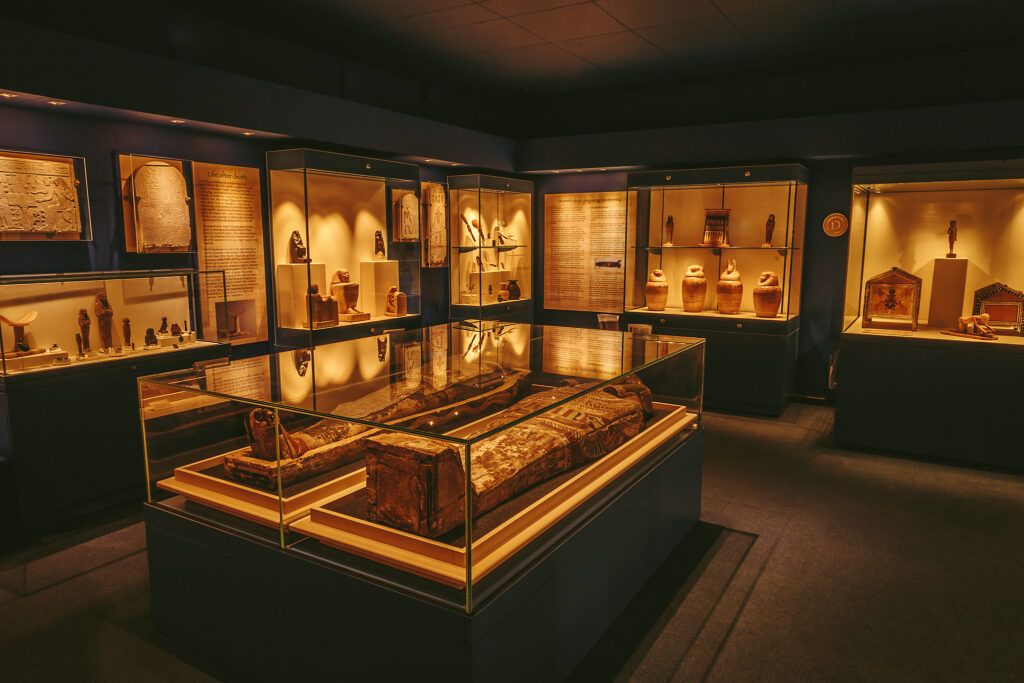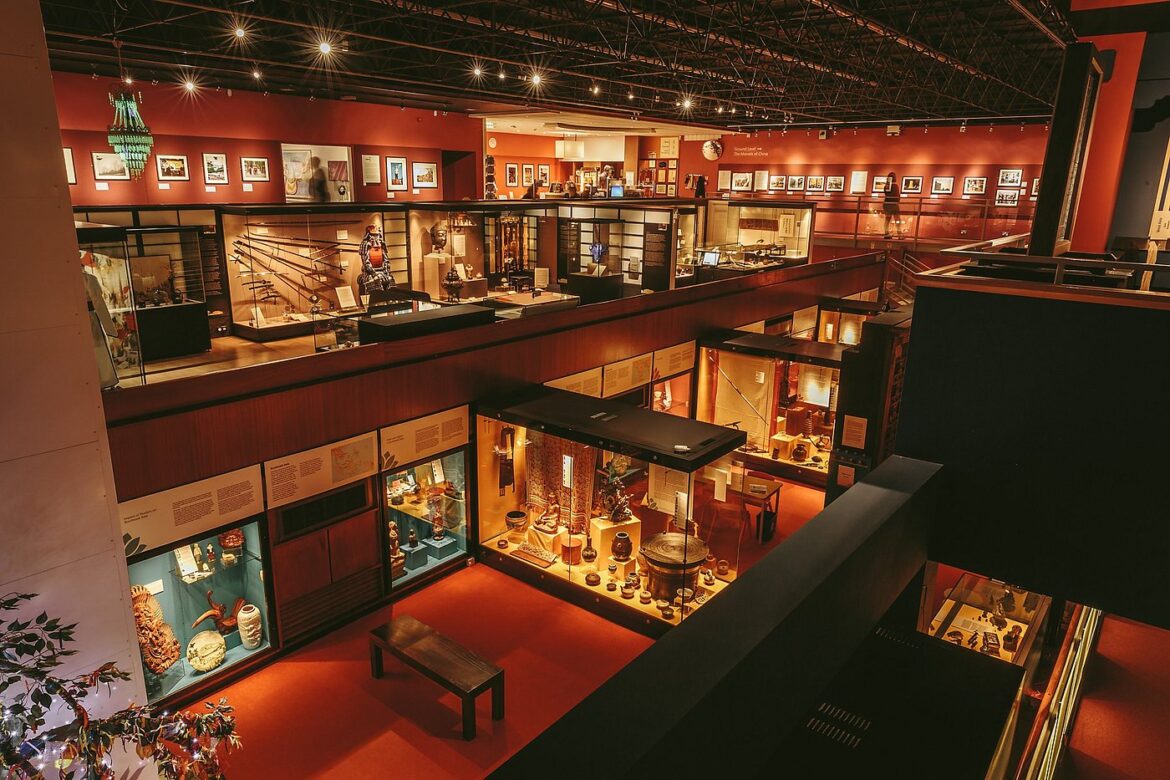The Durham University Oriental Museum, nestled on Elvet Hill in Durham, is a unique cultural gem: the only museum in northern England devoted entirely to the art and archaeology of North Africa, Asia, and the Indian subcontinent. With over 30,000 objects spanning millennia—from prehistoric relics to contemporary art—the museum offers an enriching journey through multiple civilisations and artistic traditions.

Origins and Purpose
Established in 1960 as the Gulbenkian Museum of Oriental Art and Archaeology, the museum was created to support Durham University’s expanding School of Oriental Studies. Key early acquisitions included:
- The Northumberland Collection of Egyptian and Near Eastern antiquities
- Over 3,000 Chinese ceramics and jades donated by Malcolm MacDonald and Sir Charles Hardinge
A National Lottery Heritage Fund grant in 1999 enabled the installation of a mezzanine gallery and modern visitor facilities, significantly enhancing exhibition and educational spaces.
Permanent Galleries: Regional Treasures
The museum’s galleries are arranged geographically, allowing you to tour entire regions or dive into specific cultures:
Ancient Egypt & Sudan
Featuring over 6,000 Egyptian and Sudanese items, including mummies, coffins, amulets, canopic jars, and pottery from various dynasties.
China
One of the UK’s most significant Chinese collections outside London, with over 10,000 objects. Highlights include:
- Imperial porcelain from the Song, Ming, and Qing dynasties
- 2,000+ pieces of jade and hardstone carvings
- Costume, bronze wares, calligraphy, photography, prints, and the museum’s largest exhibit: a carved Qing dynasty bed with boxwood and ivory panels
The collection received elite Designated Collection status in 2008, and further collaboration with the Palace Museum Beijing in 2016.
Japan & Korea
The Japanese gallery includes samurai armour, tea ceremony objects, and Edo-period Ukiyo‑e prints, while the Korean gallery features celadon pottery and rare artefacts from both North and South Korea.
South & Southeast Asia, and the Himalayas
From Indus Valley ceramics (dating as far back as 2,500 BCE) to Southeast Asian textiles, Himalayan artefacts, ritual objects, and traditional weapons, the regional galleries explore diverse cultures and histories.
Silk Roads
This thematic gallery brings together selected objects from multiple regions, illustrating centuries of trade, exchange, and cultural dialogue across Asia and into Europe.
🎓 Education, Events & Community
Learning for Everyone
The museum is fully committed to education and community engagement. It offers:
- Workshops on Chinese calligraphy, Japanese origami, and more
- Free family events like dress-up sessions and storytelling
- Programs for seniors, under‑5s, schoolchildren, and special interest groups
Community Partnerships
Since 2012, the Oriental Museum has supported the Durham Chinese School, providing a cultural hub for language learning, events, and community outreach.
Talks & Exhibitions
Regular gallery talks, curator-led tours, and special exhibitions (seasonal or themed) enrich the visitor experience and invite deeper engagement with the collections.
Visitor Experience & Practical Info
Visiting Hours & Admission
- Free entry to all visitors
- Open Tuesday–Friday: 10 am–5 pm, Saturday–Sunday (and bank holidays): 12 pm–5 pm
- Selected evening openings until 7 pm occur on the 1st and 3rd Thursday of April–October and the 1st Thursday of November–March
Plan for at least two hours to explore the museum fully, including seating and interactive exhibits across four floors.
Visitor Facilities
- Visitor desk offering guidance and event information
- A gift shop themed by region (China, Japan, Korea, India, Ancient Egypt), with items sourced ethically or Fairtrade whenever possible
- A small café serving Fairtrade coffee, speciality teas, snacks, and seating for around 16 people (additional space can be arranged for groups)
- Accessibility: wheelchair access, unisex and baby-changing toilets, lockers, electric vehicle charging in the car park, and inclusive seating areas
Group Visits
Pre‑booked daily group visits (recommended max 20–30 people) can include gallery tours or curated handling sessions. Museum staff tailor presentations to group interests and age ranges.
Special Highlights & Stories
- In 1969, a fragment of moon rock displayed here attracted over 12,000 visitors in just two days and extended museum opening hours to accommodate the crowds.
- In 2012, Chinese artefacts—with a value of nearly £2 million—were stolen but later recovered; the perpetrators received prison sentences in 2013.
- The museum continues to build meaningful partnerships, including its collaboration with the Palace Museum Beijing, underscoring its international curatorial reach.
Why Visit Durham Oriental Museum?
- It’s a one-of-a-kind museum in northern England, unmatched in scope for Asian and Near Eastern collections.
- Its designated collections—notably Chinese and Egyptian artefacts—are nationally and internationally significant .
- It offers inclusive learning and engagement for all ages, from under‑5s to adult learners.
- The museum represents a bridge between university research and local community, exemplified by partnerships like Durham Chinese School.
Suggested Visit Itinerary
- Arrival & Visitor Desk: Gather orientation info, grab a map, and learn about current exhibitions.
- Choose a Starting Region: Egypt and China galleries are especially rich in artefacts and storytelling.
- Explore Silk Roads Gallery: Discover cross-cultural exchange crafted through stunning objects.
- Join a Workshop or Talk: Events often include hands-on crafts or curator insights.
- Gift Shop Browsing: Find region-themed souvenirs and books, including ethically sourced items.
- Relax in Café: Unwind with local snacks and tea or coffee in a calm setting.
- Finish with a Gallery on Japan or Korea: Perfect ending with elegant craftsmanship or dramatic samurai armour.
The Durham Oriental Museum is far more than a university collection—it is a vibrant cultural institution that invites exploration, reflection, and connection across continents. Whether you’re drawn by historical depth, artistic beauty, or educational programming, the museum offers a world of discovery right here in Durham.

